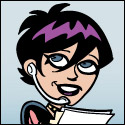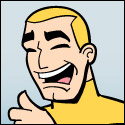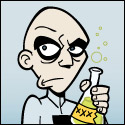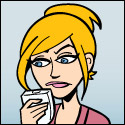The Business of Revamps with Bill Walko
Bill Walko is having fun. Known as the historian for all things Teen Titans at Titans Tower, Bill is branching out into webcomics with the hilarious, satirical love-letter to superhero comics: The Hero Business. Now wrapping up its second story arc, about the sometimes misguided attempts to make a long-standing character “more accessible” and “more relevant”, Bill sat down and talked about his inspirations for the series.
Bob Francis: Jumping right into things, let’s talk about the beginnings of The Hero Business. How long has this idea been developing, and where did it come from?
Bill Walko: Oh, it came from the most natural place of all: my own life! A couple of years ago, I was batting around some ideas. I really wanted to do something fun using super-heroes and all the clichés and trappings they bring with them. I approached it very much like a sit-com. I had some vague ideas of the characters, but I still needed the “situation” to drive the “comedy.”
I was always a fan of smart workplace comedies like Cheers, Mary Tyler Moore, Newsradio, The Office and 30 Rock. I wanted the comic equivalent of that. Now, in addition to being an artist, I’m also a graphic designer. So I’ve been working in the wild world of marketing agencies for over 10 years. It’s really interesting what goes into marketing, from concept to public relations to logo development.
I starting thinking, what if there was a marketing agency for super-heroes? An entity that arranged those seemingly accidental super-team ups? An agent negotiating for your center spot in super-team group shots? A PR person covering up the lascivious antics of the “world’s greatest heroes”? Much like real life, the super-celebrity heroes would be created and supported by a clever (and sometimes unscrupulous) behind-the-scenes marketing machine.
And then the name came to me: The Hero Business. And I knew I had something I could work with. Combining my marketing agency know-how with my super-hero aptitude, I could merge the silliness and excesses of both worlds. Because, as I say, “with great power comes great marketability.”
BF: Who are Parker, Morgan, Simon, Dr. Malefactor, Bravado, and Brody? And which, if any, are you most proud of? Personally, I like Morgan Sinclaire. She always seems in control of the situation and her surroundings. Tell me she’ll have a spotlight arc. (Ha!)
BW: When I developed the cast, I really wanted a mix of the super-powered and non-super-powered. And, I developed them by specific character types that would all play well off each other in some way. Put any two of them in a room together, and you could generate some good interaction and humor.
Parker, the new Hero Business receptionist, is our entry character. We largely see things through her eyes in the first storyline. But if you’ve read it, you also know the story turns on its ear in the last page when we reveal her secret, so she goes from our entry character to somewhat of a mystery character. She’s likable, sarcastic and a tad cynical. And right now, she has the ability to surprise readers. Parker’s overall story arc dominates what I’m calling “the first season”, which is comprised of six story lines.
Bravado was built from the classic super-hero model of the Silver and Bronze Age. He still says things like “Blast!” and “Holy Spit!” He’s somewhat of a has-been, except in his own mind. He serves as the spokesperson and super-hero consultant for the agency, and he’s quite the blowhard. He also bristles at the modern heroes of today, insisting “real men don’t wear Kevlar.” The Hero Business attempted to give Bravado a modern day upgrade in the just-completed second storyline, “The All-New, All-Different Bravado.”
Dr. Eli Malefactor was once a major super-villain, but the down-on-his-luck evil genius decided to reform. Now, he works at The Hero Business heading up Research and Development. And, oh, he also has to work with his long-time arch-enemy, Bravado. The idea of an evil mad scientist working at the company brings a lot of fun story potential, and Malefactor’s become quite a break-out character with the readers. We delve deeper into Malefactor with the third storyline, “Cry, Malefactor.”
Morgan, the Public Relations Expert, is based on women I’ve worked with at marketing agencies; She’s smart, savvy and sexy, but a bit of a workaholic. She’s usually a couple of steps ahead of the group, although conniving Simon gives her a run for her money. Like many cast members, there’s even more to Morgan than meets the eye. You’ll be happy to hear she’s at the center of the fourth storyline, which also features her old school chum and best frenemy, Glamazon.
Simon, the Marketing Director, is every bottom-feeding, conniving, self-serving, unscrupulous Account Person I’ve ever worked with. And I’ve worked with a lot of them! Simon likes to put on that slick persona, and fancies himself quite the charmer. He’s a lot of fun to write because he’s an instigator. He can be an enemy or an ally, but his actions are always ultimately serving himself. And, oh, he’s got a thing for Morgan. We’ll see one of Simon’s grand schemes in the fifth storyline.
And then there’s Brody, our frustrated Art Director. Brody is often a victim of circumstance, trying to preserve his artistic vision in the face of fussy super-heroes and co-workers who wrestle for creative control. Brody’s views may or may not be based on my own experiences as a designer. OK, they totally are.
I’m proud of all the characters, so it’s hard to choose a favorite. Right now, I’d have to say Parker. Ask me another day, I might have a different answer.
BF: Revamps and Reboots have been a recurring theme in your series, from hilarious “Fill out an Un-Death Certificate” page to Amerigirl to “All New, All Different Bravado”. You’ve treated this in a satirical and tongue and cheek way, but what are your feelings about revamps?
BW: I think revamps are both good and bad, but they are usually approached with the best of intentions. The creatively-driven ones I can respect for the attempt to try something new. Some of the more contrived-by-committee revamps usually feel forced, and they’re harder to make work.
But hey, there’s been some awesome revamps from the 70s Uncanny X-Men to the 80s New Teen Titans to Miller’s Daredevil to Byrne’s Superman to Gaiman’s Sandman. And then there’s botched revamps from teenage Tony Stark to the Spider-Man Clone Saga to Bart Allen as the Flash. I think it’s just more fun to mock the bad ones, y’know? Especially the spectacularly bad ones. But the endless revamps are just part of comic book lore now, as these characters never age but still need to be modernized every few years.
It’s funny that people think I’m slamming something specific in some of my comics, when they are often written more broadly. The tone I’m shooting for is fun and satirical, not mean-spirited and scathing.
BF: In general, is there such a thing as a necessary revamp or reboot? If so, what makes a revamp successful?
BW: I think just about every comic book character needs to be updated and revamped every few years. The trick is to keep the essence of the character and modernize the trappings. Marvel generally does a great job at this because they are constantly doing “soft reboots” – slight variations on costumes and thematics. I think, in general, revamps should be about moving forward, not looking back. Just update the tone and trappings and think of new challenges and situations to put your characters in.
The success of revamps is ultimately up the audience, really. Because comic books are serialized fiction, it becomes obvious when a revamp or a reboot isn’t taking hold. Bart Allen as the Flash is probably a good example of that. The Spider-Man Clone Saga, too. In both instances, they eventually packed up those storylines, shifted gears, and reverted back to the status quos of those characters.
I have several reboot/revamp jokes scribbled into my notebook, so clearly, it’s an area ripe for parody!
BF: Back to the webcomic, who are your biggest influences in writing and art?
BW: From an art perspective, I’d say Bruce Timm and Dan DeCarlo largely inform my style. I’m also amazed and influenced by Shag’s hispter art, Jamie Hewlett’s stylish Gorillaz characters, Mike Weiringo’s cartoony super-heroes, Karl Kerschl’s expressive work, Amanda Conner’s vibrant art, Genndy Tartakovsky’s super-slick style, Scott McCloud’s brilliant simplicity, and the timeless but stylized look of artists like Darwyn Cooke and Eric Wight.
From a writing perspective, it’s a number of influences. I love how Joss Whedon deftly mixes comedy, drama and balances longer story arcs. I marvel at the economy of language and images in Will Eisner’s work. I’m fascinated by Gary Larson’s absurdist eye. Shows like the Venture Brothers, Futurama and old school Simpsons do a great job of colliding the super-fantastic with the mundane. The aforementioned great world place sit-coms (Cheers, Mary Tyler Moore, Newsradio, The Office and 30 Rock) are great inspiration, to see how they escalate events as they build characters. It’s a little bit of all of that.
I really play around with some different approaches. My done-in-one “Coffee Break” gags are largely inspired by both the cold opening scenes from Cheers as well as great classic comic strips. The storylines are approached more like an episode of an animated series you’d find of FOX Sunday night or on Cartoon Network’s Adult Swim block.
So whether you enjoy sit-coms, satirical animated series or comic book humor, hopefully there’s something to entertain you in The Hero Business universe.






